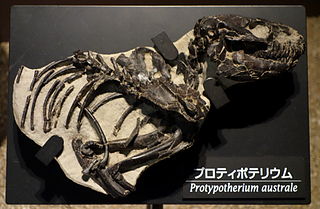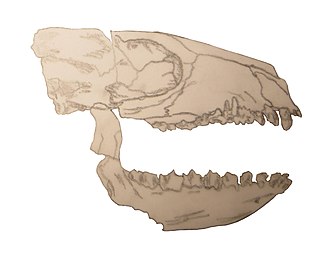
Xenungulata is an order of extinct and primitive South American hoofed mammals that lived from the Late Paleocene to Early Eocene. Fossils of the order are known from deposits in Brazil, Argentina, Peru, and Colombia. The best known member of this enigmatic order is the genus Carodnia, a tapir-like and -sized animal with a gait similar to living African elephants.

Protypotherium is an extinct genus of notoungulate mammals native to South America during the Oligocene and Miocene epochs. A number of closely related animals date back further, to the Eocene. Fossils of Protypotherium have been found in the Deseadan Fray Bentos Formation of Uruguay, Muyu Huasi and Nazareno Formations of Bolivia, Cura-Mallín and Río Frías Formations of Chile, and Santa Cruz, Salicas, Ituzaingó, Aisol, Cerro Azul, Cerro Bandera, Cerro Boleadoras, Chichinales, Sarmiento and Collón Curá Formations of Argentina.

Cramauchenia is an extinct genus of litoptern South American ungulate. Cramauchenia was named by Florentino Ameghino. The name has no literal translation. Instead, it is an anagram of the name of a related genus Macrauchenia. This genus was initially discovered in the Sarmiento Formation in the Chubut Province, in Argentina, and later it was found in the Chichinales Formation in the Río Negro Province and the Cerro Bandera Formation in Neuquén, also in Argentina, in sediments assigned to the SALMA Colhuehuapian, as well as the Agua de la Piedra Formation in Mendoza, in sediments dated to the Deseadan. In 1981 Soria made C. insolita a junior synonym of C. normalis. A specimen of C. normalis was described in 2010 from Cabeza Blanca in the Sarmiento Formation, in sediments assigned to the Deseadan SALMA.

Carodnia is an extinct genus of South American ungulate known from the Early Eocene of Brazil, Argentina, and Peru. Carodnia is placed in the order Xenungulata together with Etayoa and Notoetayoa.

Astrapotheria is an extinct order of South American and Antarctic hoofed mammals that existed from the late Paleocene to the Middle Miocene, 59 to 11.8 million years ago. Astrapotheres were large, rhinoceros-like animals and have been called one of the most bizarre orders of mammals with an enigmatic evolutionary history.

Neolicaphrium is an extinct genus of ungulate mammal belonging to the extinct order Litopterna. This animal lived from the Late Pliocene (Chapadmalalan) to the Late Pleistocene (Lujanian) in southern South America, being the last survivor of the family Proterotheriidae.
The Río Loro Formation is a geological formation of the Sierras Pampeanas in Tucumán Province Argentina whose strata date back to the Late Paleocene of the Paleogene, or Riochican in the SALMA classification.
Ernestokokenia is an extinct genus of mammal, belonging to the Didolodontidae. It lived during the Early Eocene and the Middle Eocene, and its fossils were discovered in South America.
Saltaodus is an extinct genus of mammals, belonging to the family Didolodontidae. It lived during the Late Eocene, in what is now South America.

Eoastrapostylops is an extinct genus of astrapothere that lived during the Late Paleocene in what is now Argentina.
Tetragonostylops is an extinct genus of mammal, related to Astrapotheria. It lived during the Late Paleocene, and its fossils were discovered in South America.
Polymorphis is an extinct genus of litopterns belonging to the family Macraucheniidae. It lived during the Middle Eocene of Argentina.

Adiantoides is an extinct genus of herbivorous mammal, belonging to the order Litopterna. It lived during the Middle to Late Eocene, in South America.
Wainka is an extinct genus of South American mammal, belonging to the order Litopterna. It lived during the Middle Paleocene.
Proectocion is an extinct genus of adianthid litoptern. It lived during the Early Eocene, in what is now South America.
Requisia is an extinct genus of litoptern from the Early Paleocene of Argentina. Its fossilized remains were found in the Salamanca Formation in the Chubut Province. It is a monotypic genus, its only known species being Requisia vidmari.

Periphragnis is an extinct genus of isotemnid notoungulates that lived from the Middle Eocene to the Early Oligocene in what is now Argentina and Chile.
Archaeopithecus is an extinct genus of notoungulate, belonging to the suborder Typotheria. It lived during the Middle Eocene, in what is today Argentina.
Pternoconius is an extinct genus of macraucheniid litoptern from the Late Oligocene and Early Miocene of Argentina. Fossils of this genus have been found in the Sarmiento Formation of Argentina.
Adianthidae is an extinct family of litopterns that existed from the Middle Eocene (Mustersan) to the Early Miocene (Santacrucian).
This page is based on this
Wikipedia article Text is available under the
CC BY-SA 4.0 license; additional terms may apply.
Images, videos and audio are available under their respective licenses.
















